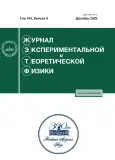Thermoelectric Power and Hall Effect in Correlated Metals and Doped Mott–Hubbard Insulators: DMFT Approximation
- 作者: Kuchinskiy E.Z.1, Kuleeva N.A.1, Sadovskiy M.V.1
-
隶属关系:
- Institute for Electrophysics, Ural Branch, Russian Academy of Sciences
- 期: 卷 164, 编号 6 (2023)
- 页面: 1056-1069
- 栏目: Articles
- URL: https://journals.rcsi.science/0044-4510/article/view/247369
- DOI: https://doi.org/10.31857/S0044451023120180
- EDN: https://elibrary.ru/MYGZSV
- ID: 247369
如何引用文章
全文:
详细
We present comparative theoretical investigation of thermoelectric power and Hall effect in the Hubbard model for correlated metal and Mott insulator (considered as prototype cuprate superconductor) for different concentrations of current carriers. Analysis is performed within standard DMFT approximation. For Mott insulator we consider the typical case of partial filling of the lower Hubbard band (hole doping). We calculate the dependence of thermopower on doping level and determine the critical concentration of carriers corresponding to sign change of thermopower. An anomalous dependence of thermopower on temperature is obtained significantly different from linear temperature dependence typical for the usual metals. The role of disorder scattering is analyzed on qualitative level. The comparison with similar studies of the Hall effect shows, that breaking of electron-hole symmetry leads to the appearance of the relatively large interval of band-fillings (close to the half-filling) where thermopower and Hall effects have different signs. We propose a certain scheme allowing to determine the number of carriers from ARPES data and perform semi-quantitative estimate of both thermopower and Hall coefficient using the usual DFT calculations of electronic spectrum.
作者简介
E. Kuchinskiy
Institute for Electrophysics, Ural Branch, Russian Academy of Sciences
Email: kuchinsk@iep.uran.ru
620016, Yekaterinburg, Russia
N. Kuleeva
Institute for Electrophysics, Ural Branch, Russian Academy of Sciences
Email: kuchinsk@iep.uran.ru
620016, Yekaterinburg, Russia
M. Sadovskiy
Institute for Electrophysics, Ural Branch, Russian Academy of Sciences
编辑信件的主要联系方式.
Email: sadovski@iep.uran.ru
620016, Yekaterinburg, Russia
参考
- Th. Pruschke, M. Jarrell, and J. K. Freericks, Adv. Phys. 44, 187 (1995).
- A. Georges, G. Kotliar, W. Krauth, and M. J. Rozenberg, Rev. Mod. Phys. 68, 13 (1996).
- D. Vollhardt, in Lectures on the Physics of Strongly Correlated Systems XIV, ed. by A. Avella and F. Mancini, AIP Conf. Proc., AIP, Melville, New York, Vol. 1297 (2010), p. 339; ArXiV: 1004.5069.
- Э. З. Кучинский, Н. А. Кулеева, Д. И. Хомский, М. В. Садовский, Письма ЖЭТФ 115, 444 (2022)
- JETP Letters 115, 402 (2022).
- Э. З. Кучинский, Н. А. Кулеева, М. В. Садовский, Д. И. Хомский, ЖЭТФ 163, 417 (2023)
- JETP 136, 368 (2023).
- Э. З. Кучинский, И. А. Некрасов, М. В. Садовский, УФН 182, 345 (2012)
- Physics Uspekhi, 55, 325 (2012).
- G. Rohringer, H. Hafermann, A. Toschi, A. A. Katanin, A. E. Antipov, M. I. Katsnelson, A. I. Lichtenstein, A. N. Rubtsov, and K. Held, Rev. Mod. Phys. 90, 025003 (2018).
- О. Маделунг, Теория твердого тела, Наука, Москва (1980)
- O. Madelung, Festk¨orpertheorie, Springer-Verlag, Berlin (1973).
- S. Chakraborty, D. Galanakis, and P. Phillips, Phys. Rev. B 82, 214503 (2010).
- R. Bulla, T. A. Costi, and T. Pruschke, Rev. Mod. Phys. 60, 395 (2008).
- Дж. Займан, Принципы теории твердого тела, Мир, Москва (1974)
- J. Ziman, Principles of the Theory of Solids, Cambridge University Press (1973).
- G. Beni, Phys. Rev. B 19, 2186 (1974).
- W. O. Wang, J. K. Ding, E. W. Huang, B. Moritz, and Th. P. Devereaux, arXiv: 2302.13169.
- E. Z. Kuchinskii, I. A. Nekrasov, and M. V. Sadovskii, ЖЭТФ 133, 670 (2008)
- JETP 106, 581 (2008).
- M. V. Sadovskii, I. A. Nekrasov, E. Z. Kuchinskii, Th. Pruschke, and V. I. Anisimov, Phys. Rev. B72, 155105 (2005).
- Wenhu Xu, K. Haule, and G. Kotliar, Phys. Rev. Lett. 111, 036401 (2013).
- R. S. Allgaier, Phys. Rev. 185, 227 (1969).
- Н. Мотт, Э. Дэвис, Электронные процессы в некристаллических веществах, Мир, Москва (1982)
- N. F. Mott, E. A. Davis, Electron Processes in Non-Crystalline Materials, Clarendon Press, Oxford (1979).
- S. D. Obertelli, J. R. Cooper, and J. L. Tallon, Phys. Rev. B 46, 14928 (1992).
- T. Honma and P. H. Hor, Phys. Rev. B 77, 184520 (2008).
- A. Garg, B. Sriram Shastry, K. B. Dave, and P. Phillips, New J. of Phys. 13, 08332 (2011).
- F. F. Balakirev, J. B. Betts, A. Migliori, I. Tsukada, Y. Ando, and G. S. Boebinger, Phys. Rev. Lett. 101, 017004 (2009).
- S. Badoux, W. Tabis, F. Laliberte, B. Vignolle, D. Vignolles, J. Beard, D. A. Bonn, W. N. Hardy, R. Liang, N. Doiron-Leyraud, L. Taillefer, and C. Proust, Nature 531, 210 (2016).
- C. Collignon, S. Badoux, S. A. A. Afshar, B. Michon, F. Laliberte, O. Cyr-Choiniere, J.-S. Zhou, S. Licciardello, S. Wiedmann, N. Doiron-Leyraud, anf L. Taillefer, Phys. Rev. B95, 224517 (2017).
- C. Proust and L. Taillefer, Annu. Rev. Condens. Matter Phys. 10 409 (2019).
补充文件









